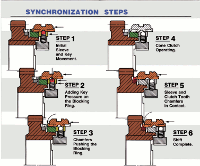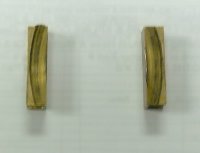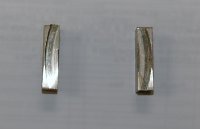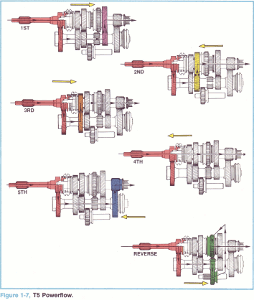The most abused components in a vehicle are the clutch and the
manual transmission as these components are completely at the mercy
of the driver. Most of this discussion will be tilted to
performance vehicleS because they make up the vast majority of
domestic cars that are still available with "stick transmissions".
The same parameters of this discussion apply to foreign cars also,
and of course the few pickup truck and SUVs that are still optioned
with a manual transmission. The driver who chooses a manual
transmission does so for more complete control of their driving
experience. Since on the domestic side the only real volume of
manually shifted vehicles you will see in your shop are Corvettes,
Vipers, Challengers, Camaros, GTO's, Cadillac CTS-Vs, and Mustangs,
some of which will be used in actual competition by weekend
warriors and others will be tried out for enjoyment and for the
impression of the female species.

Click on image to see more
The road to ruin begins with the clutch. The primary issue with
transmission damage is an improperly releasing clutch. A worn or
slipping clutch causes a lack of torque transfer from the engine to
the transmission, but does the transmission little or no harm. In
order to have the synchronizers in the transmission function
properly for smooth clash free shifts, the clutch must fully
release when depressed, disconnecting the motor from the
transmission completely and cleanly. The amount of pedal travel
(2-4 inches on average) will result in an air gap at the disc of
about 50/1000ths of an inch. The motor is not transferring torque
into the transmission, and the output shaft of the trans is now
being driven by the drive wheels. If there is no disconnect between
the engine and transmission due to an improperly adjusted clutch
travel, the synchronizers are now fighting the engine torque load.
This causes grinding notchy shifts which will destroy the
synchronizer or blocker rings, the engagement teeth on the speed
gears and synchro sliding sleeves, the synchronizer keys, shift
fork pads and the forks themselves. Whenever you see the steel keys
broken or sheared off, there can only be several causes. The first
is improper or no clutch release, driver error where the clutch is
not released or trying to shift without using the clutch or a
driver that is moving the shift lever before the clutch has
released, rushing the shift. A common attempt at curing this
problem is frequently to use billet solid keys because the common
error is to put the fault on the factory keys. If the clutch
release issue is not resolved, the billet keys may be tough enough
to survive their environment, but the synchro rings will crack, or
the key slots will distort, the synchro hub may crack, or a shift
fork will break. None of this is the fault of the key, but either
the driver's bad habits or the synchronizer trying to overcome all
the torque load transmitted at the crankshaft. Tremec, ZF, and many
other manufacturers have gone away from using keys in the
synchronizers, replacing them with spring loaded balls and struts.
These components will handle more abuse without breaking, but in
the end the synchronizers and speed gears will die of torque
induced fatigue.
Another point of early transmission failure is the wrong choice
of clutch for the application. This usually begins with the idea
that installing a performance clutch will improve the vehicle
performance. There are a great variety of clutch sets available on
the performance side and many car owners do not understand what
they were designed for when making a purchase. The correct setup
will definitely improve performance over stock, and the wrong
clutch will make driving a misery and create big time trans
failure. We see all the time that an owner has opted to install a
full racing clutch in a street driven vehicle. In many cases the
friction material is way too aggressive for use in traffic , which
shock loads the gear train causing broken inputs, clusters and
speed gears, as well as possible damage to the differential and
drive shaft. It is very important to match the clutch to the
vehicle usage. A car that is only track driven can handle more
aggressive setups, while a car that is a daily driver with
occasional trips to the drag strip will be no fun to drive in
traffic with a clutch that acts like an on/off switch. This happens
very frequently in light trucks, where somebody's cousin tells him
that the way to go is a ceramic button type of disc instead of the
factory woven friction material. They both will work, but the
aggressive grab of the button clutch puts the trans at risk as well
as making his girlfriend puke sick. Again if the clutch is not
releasing properly, the button type or dual disc clutches will
increase the failures dramatically. One other issue that results in
very rapid transmission damage similar to overly aggressive clutch
friction material is the choice of the clutch disc itself. The
vehicle was manufactured with a clutch disc that had a sprung hub.
This allows the disc as it engages the flywheel and pressure plate
to turn against the springs in the hub absorbing the shock load and
removing harmonic vibrations that cause gear rattle and other noise
issues due to engine harmonic vibrations. In the quest for better
performance the owner may substitute a solid or unsprung clutch
disc, eliminating the cushion effects engineered into the OEM
product. An unsprung clutch hub should only be used in a purpose
built race vehicle where the owner intends to freshen up the clutch
and trans every race or two. The unsprung hub will definitely
shorten the component life of the transmission.


Click on the images to see more
Another cause of transmission failure is lubrication. Everyone
knows that lack of lube fill due to leaks or lack of maintenance is
the kiss of death for any component, but the type and quality of
lube is very misunderstood. Modern synchronizer rings are designed
to be used with a specific lubricant which will be specified in the
owner's manual. A synchro ring is a wet clutch, designed to grab
the cone of the speed gear during a shift and speed it up or slow
it down to match the input shaft speed to the output shaft. These
rings are manufactured from many different compounds each of which
has a different coefficient of friction. Brass and bronze rings
have been replaced in many units by sintered metal or carbon fiber
rings. There are no modern units left that will run on the old
75/90 weight gear oil. That oil is too thick to be exhausted from
under the ring in the milliseconds it takes to make the shift, and
since many of the new compounds are porous, if the wrong oil is
used it will remain impregnated in the ring, and the ring will
never function properly. Always be sure to use an oil that is
specified for the model of trans in the vehicle. There are improved
aftermarket oils but be careful as many contain compounds that
carbon fiber rings in particular will not do well with.
The amount of lubrication is also critical for shift timing.
Overfilling a manual transmission will cause fluid to leave from
the vent but will create windage problems. Windage is the effort
needed for the gears to turn through the oil level. Dry sump race
motors make more horsepower than a stock wet sump motor because the
crankshaft is not fighting the oil in the bottom of the pan. Think
of it as trying to run on a beach. It takes little effort to run on
the hard packed sand near the tide line, but a great effort to run
through 6 inches of water in the surf. When a manual trans is over
filled and the driver makes a shift, the gear trains slows down
very quickly when the clutch is depressed because of the fluid
drag, altering the synchronizer timing and causing shift issues. A
classic case of this was the Tremec 3650 series of 5 speed
transmissions where the fill plug was actually designed too high in
the case. On these units you cannot" fill to spill", but to ½ inch
below the fill plug level for proper operation.
An area that creates more transmission issues is the shifter. It
is common to install a "short throw shifter" into a manual trans
equipped vehicle. The shifter is designed to shorten the amount of
movement in the stock shifter making the shifts happen quicker.
There are many excellent short throw shifters on the market and
they do improve the shift sequence. However the driver needs to
understand that the time it takes to shift is predicated on how
fast the synchronizer can complete the shift without gear clash.
When you shorten the throw of the shifter it is possible for the
driver to be moving the stick faster than the clutch can fully
release, and before the synchronizer can complete the function of
matching the input shaft speed to the output shaft speed. This
results in grinding or blocked out shifts as the timing has been
altered for the function of the components. Another issue we have
seen over the years is the lack of vibration deadening construction
on some aftermarket shifters. The auto manufacturers spend a
fortune trying to isolate the interior of the car from all outside
noise, vibration, and harshness (NVH). Some aftermarket shifters
will create a "buzz" from the stick, or other noises not heard or
felt with the factory stick. In any case a short throw shifter will
complicate transmission failure due to a poor clutch release or out
of time synchronization.

Click on image to see more
The art of synchronization is poorly understood by most drivers.
The synchronizer is like a zipper. Everyone knows how to use it,
but few understand how it really works. The basic understanding
begins with the design of the manual transmission. We have an input
shaft that is splined to the clutch disc and transfers torque
(rotational force)from the engine crankshaft into the gear box. The
input shaft is in line with and rides on the nose of the mainshaft
(output shaft) of the transmission, but can turn independently from
the mainshaft. The gear end of the input shaft meshes with a
countershaft or cluster gear that is mounted parallel to the input
and output shafts in the transmission case. This drives the cluster
gear, which has multiple gears on it, that mesh with the speed
gears mounted on the mainshaft. The speed gears are free- wheeling
on the mainshaft. Then we have the synchronizer assemblies that are
splined to the main shaft between the speed gears. All of the speed
gears which include the input gear have a second set of teeth on
them which engage the sliding sleeve on the synchronizer assembly.
When a shift is made the shift fork slides onto the engagement
teeth of the speed gear and that gear is now attached to the
mainshaft and transmits power from the input through the cluster
gear and back into the mainshaft driving the wheels of the vehicle.
On a 6 speed transmission you will have a 1-2 synchronizer, a 3-4
synchronizer, a 5-6-reverse synchronizer. If the synchronizer
sleeves are all centered the transmission is in neutral. The
synchronizer must have a way to engage the spinning gear without
grinding. Between the synchronizer hub and the speed gear is the
synchronizer ring (blocking ring) and a single or multiple set of
cones that are attached to the speed gear. The synchro ring or
rings turn with the synchronizer and are located in position by
keys or struts that sit in the synchronizer body and move with the
sliding sleeve. As the driver moves the shift lever to select a
gear, the synchro keys force the synchro ring or rings onto the
machined cone of the speed gear, slowing it down or speeding it up
to match the speed of the output shaft which is being rotated by
the drive shaft. With the clutch depressed, the input gear is now
rotating at engine rpm, which is considerably slower than the
output shaft if you have a proper clutch release. The synchro ring
can rotate slightly within the sliding sleeve and the teeth do not
line up with the engagement teeth on the speed gear. When the shaft
speeds equalize, the ring will move in a circular motion enough for
the sliding sleeve to completely engage the speed gear and complete
the shift. This is why they are also called blocking rings as the
block the sleeve from full engagement until the speed gear and
shaft are at the same rpm, so the shift is completed without
grinding. None of this will work unless the clutch can fully
release and disconnect the torque from the crankshaft to the input.
If you do not have that disconnect of the powerflow, you are now
trying to stop or slow 400 plus foot lbs of torque in the motor
with a small friction surface that may be 3 or 4 inches in diameter
and ¼ to ½ inch wide. This immediately damages the friction
material of the ring, and can shear of the synchronizer keys like a
guillotine. Once that happens you will have blocked out or grinding
shifts as the sliding sleeve clashes with the engagement teeth on
the speed gear. Up shifts require a lot less synchronizer effort
than down shifts. Drivers who wish to slow the gear box down by
using the transmission find out that brakes are a lot cheaper than
transmissions. Careful shifting, particularly on down shifts,
prevent a shift from 5th to 1st which is really hard on the trans
and engine. Rev limiters in modern cars prevent over revving the
motor on up shifts, but cannot control engine speed on
downshifts.
We get many calls from people who have rebuilt their
transmissions and now have bearing noise issues or notchy shifts.
If you are rebuilding the gear box it is very important to
thoroughly clean all of the components, including the synchronizer
assemblies. Before taking the sliding sleeve off the synchronizer
hub, match mark the hub and the slider so that it can be
reassembled on the same splines. Metallic debris will accumulate
between the slider and the hub and if you do not clean them
completely, fresh lube will wash out the metal causing premature
bearing failure. When there is a synchronizer failure, the shift
fork pads will suffer. Many people opt to replace the plastic pads
with brass or bronze pads as an upgrade. There is no reason to do
this. The sliding sleeve is machined at the fork groove with a
micro finish that is designed for plastic pads not metal. If the
clutch is fully released there is very little load on the fork
pads. Using metal pads as an upgrade is a waste of money, creates
noises that were not there before, and will lead to premature pad
wear. The fork and the detent system that keep it in place cannot
hold the slider in position on the gear. The engagement teeth on
the speed gear and slider have a back taper engineered into them to
prevent the slider from hopping out of the gear under changing
throttle positions. If the pointing of the engagement teeth have
been rounded off due to a bad synchronizer ring the gear will be
hard to shift into and should be replaced. If the back taper is
worn out of the engagement teeth on the speed gear and slider you
will get gear jump out.
As you can see, most transmission failures begin outside the
transmission with a poor clutch release or a sloppy driver. In
vehicles equipped with automatic transmissions, the driver has very
little control over the shifts, but the manual trans has to relay
on the driver to shift properly and full release the clutch every
time.